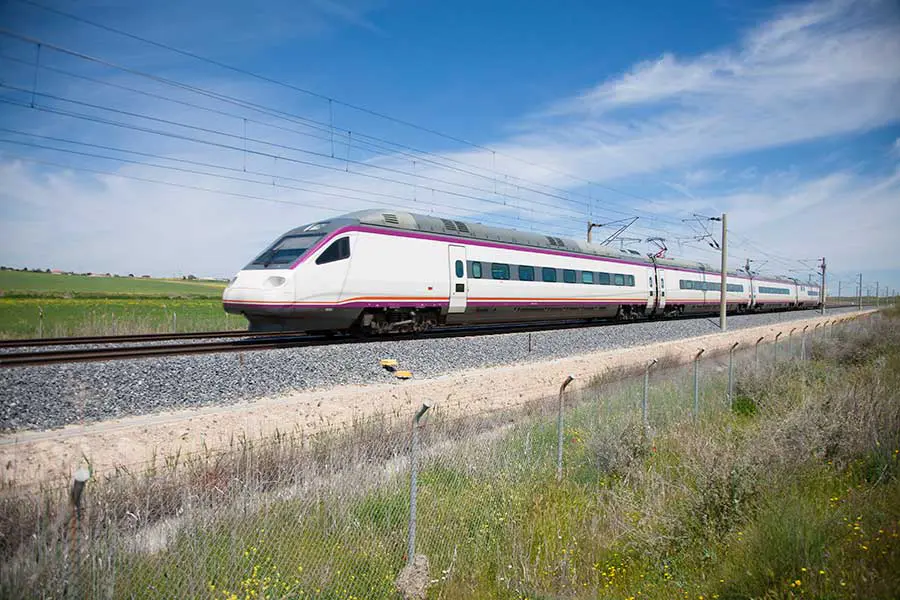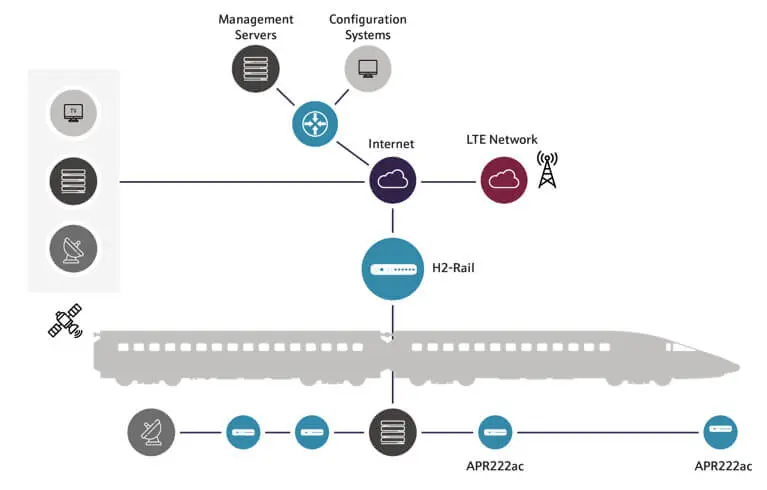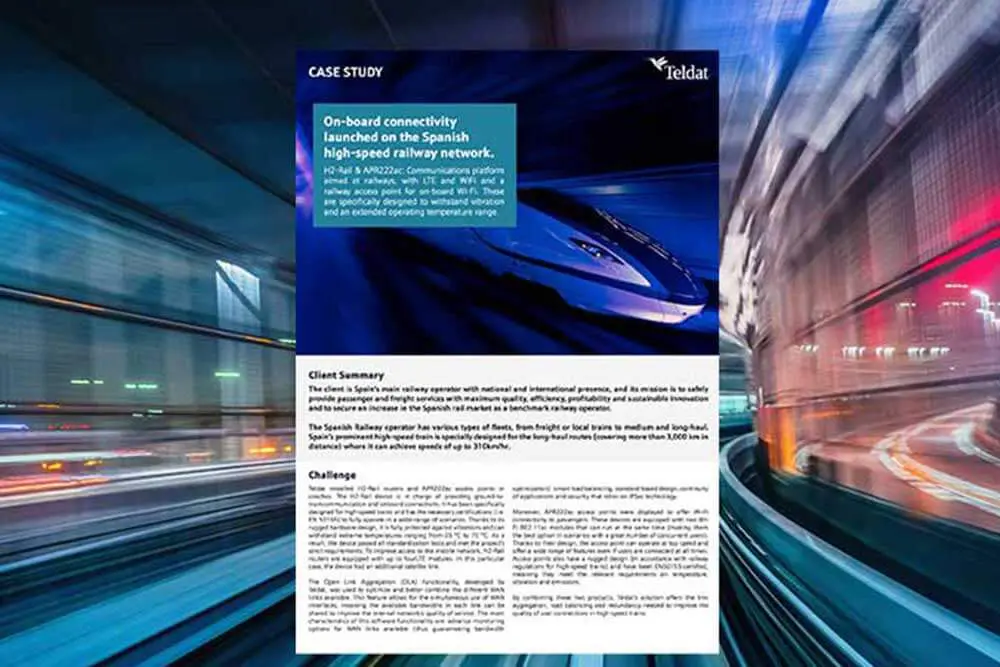Teldat H2-Rail & APR222ac
On-board connectivity launched on the Spanish high speed train network
Communications platform aimed at railways, with LTE and Wi-Fi and a railway access point for on-board Wi-Fi. These are specifically designed to withstand vibration and an extended operating temperature range.

Client Summary
The client is Spain’s main railway operator with national and international presence, and its mission is to safely provide passenger and freight services with maximum quality, efficiency, profitability and sustainable innovation and to secure an increase in the Spanish rail market as a benchmark railway operator.
The Spanish Railway operator has various types of fleets, from freight or local trains to medium and long-haul. Spain’s prominent high speed train is specially designed for the long-haul routes (covering more than 3,000 km in distance) where it can achieve speeds of up to 310 km/hr.

Why Teldat?
Being able to combine satellite and LTE/4G technologies was key when addressing the challenge faced by the railway operator. Teldat had the advantage of offering devices that were specifically designed for a railway scenario, meaning our routers were always able to guarantee the reliability of communications.
Moreover, Teldat could tweak its solution to better fit the project’s needs (obtaining the required certificates and authorizations along the way) and the company’s strong capabilities and vast experience in similar projects proved key.
Challenge
Teldat installed H2-Rail routers and APR222ac access points in coaches. The H2-Rail device is in charge of providing ground-to-traincommunication and onboard connectivity. It has been specifically designed for high speed trains and has the necessary certifications (i.e. EN 50155) to fully operate in a wide-range of scenarios. Thanks to its rugged hardware design, it is fully protected against vibrations and can withstand extreme temperatures ranging from-25 ºC to 70 ºC. As a result, the device passed all standardization tests and met the project’s strict requirements. To improve access to the mobile network, H2-Rail routers are equipped with up to fourLTE modules. In this particular case, the device had an additional satellite link.
The Open Link Aggregation (OLA) functionality, developed by Teldat, was used to optimize and better combine the different WAN links available. This feature allows for the simultaneous use of WAN interfaces, meaning the available bandwidths in each link can be shared to improve the internal network’s quality of service.
The main characteristics of this software functionality are: advance monitoring options for WAN links available (thus guaranteeing bandwidth optimization), smart load balancing, standard-based design, continuity of applications and security that relies on IPSec technology.
Moreover, APR222ac access points were displayed to offer Wi-Fi connectivity to passengers. These devices are equipped with two Wi-Fi 802.11ac modules that can run at the same time (making them the best option in scenarios with a great number of concurrent users). Thanks to their design, the access point can operate at top speed and offer a wide range of features even if users are connected at all times. Access points also have a rugged design (in accordance with railway regulations for high speed trains) and have been EN50155-certified, meaning they meet the relevant requirements on temperature, vibration and emissions.
By combining these two products, Teldat’s solution offers the link aggregation, load balancing and redundancy needed to improve the quality of user connections in high speed trains.
Solution
Teldat installed H2-Rail routers and APR222ac access points in coaches. The H2-Rail device is in charge of providing ground-to-traincommunication and onboard connectivity. It has been specifically designed for high speed trains and has the necessary certifications (i.e. EN 50155) to fully operate in a wide-range of scenarios. Thanks to its rugged hardware design, it is fully protected againstvibrations and can withstand extreme temperatures ranging from-25 ºC to 70 ºC. As a result, the device passed all standardization tests and met the project’s strict requirements. To improve access to the mobile network, H2-Rail routers are equipped with up to four LTE modules. In this particular case, the device had an additional satellite link.
The Open Link Aggregation (OLA) functionality, developed by Teldat, was used to optimize and better combine the different WAN links available. This feature allows for the simultaneous use of WAN interfaces, meaning the available bandwidths in each link can be shared to improve the internal network’s quality of service. The main characteristics of this software functionality are: advance monitoring options for WAN links available (thus guaranteeing bandwidth optimization), smart load balancing, standard-based design, continuity of applications and security that relies on IPSec technology.
Moreover, APR222ac access points were displayed to offer Wi-Fi connectivity to passengers. These devices are equipped with two Wi-Fi 802.11ac modules that can run at the same time (making them the best option in scenarios with a great number of concurrent users). Thanks to their design, the access point can operate at top speed and offer a wide range of features even if users are connectedat all times. Access points also have a rugged design (in accordance with railway regulations for high speed trains) and have been EN50155-certified, meaning they meet the relevant requirements on temperature, vibration and emissions.
By combining these two products, Teldat’s solution offers the link aggregation, load balancing and redundancy needed to improve the quality of user connections in high speed trains.

Results
Teldat has managed to successfully meet the goals and requirements of the customer, providing connectivity to the client‘s high speed trains. As a result, the customer has managed to improve the user experience of passengers by offering a highly reliable and top-quality service without connection drops (even if the train goes through areas with little coverage or passengers switch from one coach to the next).
The project was launched in December 2016 and gradually implemented during 2017. The customer can pride itself on offering one of the best and most-reliable services in the world, with over 1,600 km of high speed rail network successfully connected
Download Case Study PDF
Explore more Case Studies
A selection of case studies demonstrating how Teldat helps clients around the world, across industries, solve their toughest issues and build long-term value.
LTE & Wi-Fi on Trains
Urban Trams with Wi-Fi & Cybersecurity


























